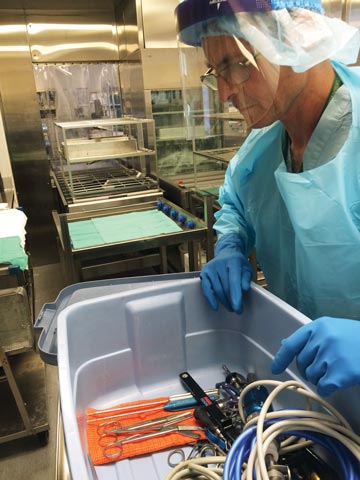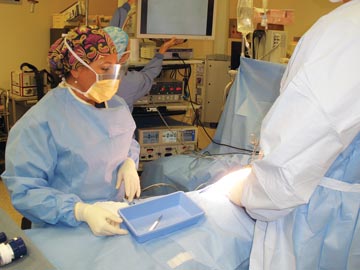Six Surface Disinfection Concepts
The puzzle of superior surface disinfection is never solved....
This website uses cookies. to enhance your browsing experience, serve personalized ads or content, and analyze our traffic. By clicking “Accept & Close”, you consent to our use of cookies. Read our Privacy Policy to learn more.
By: Dan O'Connor
Published: 1/14/2020
Let's test your knowledge of sharps safety with a few surprising facts and figures that go beyond ensuring that the surgeon and the scrub nurse never touch the same instrument at the same time with hands-free passing, no-pass zones, passing trays and single-handed scalpel blade removal. Hopefully, this will help you build a safer sharps safety program at your facility.
1. It's not just needles and scalpels. When you think of sharps injuries, needlesticks and scalpel blades probably come to mind as the clear and present dangers in the OR. And for good reason. Needlesticks are the No. 1 cause of injury among operating room personnel and scalpels are the second most frequent. Drill bits? They rank near the bottom of the sharps injury list, but they can injure and we've got the picture atop this page to prove it: a bit sticking straight up out of a scrub tech's gloved palm like a tiny javelin.
The bit was still spinning when the surgeon whipped around to pass the drill off to the unsuspecting tech, whirring fast enough to puncture the glove and penetrate the tech's skin. "The physician probably still had his foot on the power button when he pushed the drill toward the scrub tech's hand," says Susan Angelides, MSN, BSBM, CNOR, RNFA, a perioperative services consultant based in Scottsdale, Ariz., who supplied us with the photo.

2. Sharps safety extends beyond the OR. Sharps injuries can occur when and where you least suspect them, not just within the confines of the OR walls, but wherever people use, dispose of, disassemble and disinfect sharps. Year after year, 1 in 4 of all sharps injuries occur downstream to the non-user, according to sharps injury incident data from the International Safety Center Exposure Prevention Information Network (EPINet). "Keep in mind that the use and activation of safety mechanisms and proper disposal protect not just the user of the device, but those who come into contact with that device throughout its lifespan," says EPINet.
In sterile processing, for example, a tech can easily reach his hand into a tray and get poked by a concealed sharp. Jenny Crnkovich, director of central service/sterile processing at Marquette University in Milwaukee, Wis., can still see the number 11 blade glistening at the bottom of the decontamination tray, the elongated, triangular "pointy dagger" ideal for stab incisions still mounted to a number 7 knife handle.
"Nobody wants to touch the tray. You're basically reaching your hand into an incinerator," says Ms. Crnkovich. "You don't know what you're going to touch. The risk of injury is so great, a blade sharpened along the hypotenuse edge with a strong pointed tip making it and precise short cuts in shallow recessed areas.
"We assume everyone is continually capable and continually competent, but people develop bad habits and have a false confidence. Technique lapses, you lose sight of safety aspects of sharps and things happen. So many sharps incidents occur in SPD, but people don't seem to care. We don't always think about the safety of others."
Here's an idea to alert your sterile processing staff to the presence of sharps, courtesy of Christopher M. Lomboy, RN, BSN, RNFA, MBA, perioperative manager at Kaiser Permanente San Jose Medical Center Ambulatory Surgery Unit in San Jose, Calif. Repurpose those orange mats you use to designate a neutral zone for the hands-free transfer of sharps to create a sterile processing safe zone. Once the case is over, place knife handles, hooks, drill bits and all other sharps atop the orange mat so that your SPD team knows right away there are sharps in the tray.
3. More than half of incidents are not even reported. It has been estimated about half of sharps injuries go unreported. Do your staff members feel comfortable reporting a stick without fear of retaliation? And do they take sticks seriously?
"We don't treat it with caution and care. If I get poked, I get poked. We don't want to write an incident report today. High reliability is a fierce underlying problem," says Ms. Crnkovich. "No one should be afraid to report they got stuck."

4. Even when you're careful, you can get stuck. Ms. Crnkovich last got stuck almost 5 years ago when she reached down into a mesh instrument pan to grab an instrument and instead got stuck by a used needle that was supposed to be in the nearby sharps bin. Careless mistake, but not hers.
"It happens so fast. I looked and saw the needle sticking in my finger coming out of my glove," says Ms. Crnkovich. "No one was there to relieve me. I had to stay in there contaminated. When the case was done, I squeezed my finger and washed for 5 minutes and then scrubbed with betadine and alcohol. I had to go to employee health and get blood drawn to see if [the needle] was clean or contaminated."
It was clean, thankfully, but like they teach you at defensive driving, "you can't assume a surgical tech with 12 years' experience knows that it's not safe to load a blade with your hands." Toni Acello, RN, MSN, NEA-BC, director of nursing for perioperative services at Bryn Mawr (Pa.) Hospital, recalls the knife blade that cut the tendon on the surgical tech's index finger. "He wasn't expecting it because the surgeon didn't announce "blade back" and the tech was standing there with his hands out." The tech was out of work a couple months and required surgery to repair the torn tendon.
5. Sharps safety devices aren't always safe. Injuries from sharps with engineered sharps injury protections are increasing, says the CDC's Stop Sticks Campaign (osmag.net/2VzcAK). Many of these injuries are occurring before the safety mechanism is activated on a safety sharp, says the CDC. Don't let your guard down when using the devices by neglecting safe work practices; activation of the safety feature/mechanism and immediate, safe disposal is crucial.
6. Physicians don't want to be told what to do. Be it skull caps or gloves or safety sharps, surgeons will resist your changes if you don't involve them from the outset. "Early on when we started all the no-pass zones, surgeons thought it caused just a nanosecond of a delay," says Ms. Ms. Angelides. "If surgeons aren't brought along on the journey, you get a lot of resistance. They don't like to lose control." OSM
The puzzle of superior surface disinfection is never solved....
Boston Children’s Hospital is renowned for its exemplary care on many fronts, including surgery....
Manual cleaning done properly is effective for eradicating microorganisms....